Why did political parties rise and fall?
Iowa political parties, like those in other American states, respond to changes that are important to voters at the time of elections. Economic interests like taxes are always important, but sometimes moral or cultural issues like prohibition or bodily autonomy can also capture attention.The American federal system that links states to the national government also plays an important role in fostering the creation and continuation of the political party system.
Whigs and Democrats in Iowa
Before the Civil War, in Iowa's territorial and early statehood days, there were two dominant political parties: the Whigs and the Democrats. The Whigs tended to favor a more active government role in the promotion of business and economic development (building roads, promoting commerce and manufacturing, stronger currency) while Democrats favored the smallest government possible with lower taxes. However, both parties experienced internal divisions as the interests of eastern states and western states differed, and especially with growing tensions between the North and South over slavery.
In 1854, Congress passed the Kansas-Nebraska Act that allowed the settlers in western territories to decide themselves whether they would be a slave or free state. This ended the provision of the Missouri Compromise that extended the line along the Missouri-Arkansas border as the western division between slave and free territories in the West. This opened the possibility of more slave territory and was strongly opposed by many in the North of both parties. Opponents of the new law in both parties broke ranks to form first the Free-Soil Party which quickly became the Republican Party. While the Democrats continued to hold support in both North and South, the Republican Party was based almost entirely in the North, including Iowa. The Civil War cemented Iowa's loyalty to the Republican Party that continued to produce election victories at the polls until the Great Depression in the 1930s. Following World War II, Democrats began gaining strength in the cities. Today, Iowa is a two-party state and has swung both ways in recent presidential elections.
Issue-Based Party Formation
While third parties have sometimes appeared on the Iowa ballot, none has earned a significant permanent place in the political landscape. In the 1870s and 1880s, tough economic conditions for Iowa farmers led to the formation of the Populist and Greenback Parties, which encouraged the regulation of railroads, corporations and other business interests thought to be practicing unfair policies toward farmers. They also wanted more money in circulation to make borrowing and repaying interest easier. The Prohibition Party focused narrowly on efforts to eliminate the sale of alcohol, but it competed for voters with the Republicans. In 1912, supporters of Teddy Roosevelt backed him in a race against the incumbent President William Howard Taft. This split the Republican vote and allowed the Democrat Woodrow Wilson to win the White House.
In early days, candidates were nominated by political conventions. Those who had influence within the party structure played the key roles in candidate selection. In the early 1900s, Iowa amended the constitution to select candidates by direct primaries where registered voters in the party held primary elections to name the candidates. A popular candidate could gain the nomination without the support of party leaders, though this rarely happened. In 1976, the Iowa caucuses moved front and center of the national stage as the first step in the presidential nominating process. Every four years, those testing the waters for a shot at the presidency come to Iowa, providing opportunities for local voters to meet personally with top national leaders. Local politicians may step in to support one candidate or another or may keep on the sidelines so they do not offend Iowa voters or other persuasions. Regardless, national politics becomes Iowa politics every four years.
Parties are loose coalitions of citizens who rally around candidates who best promote their interests. Today, more Iowans register as "no-party" or independent than either Republican or Democrat. Among active party voters as of July 2019, registered Democrats hold a slight lead over Republicans. Republicans hold margins in the rural areas, while Democrats have urban majorities.
Supporting Questions
What economic factors impacted the rise and fall of political parties during the antebellum period?
- "Chapter X: Parties in the United States" from Democracy in America by Alexis de Tocqueville, 1835 (Document)
- "The Whale that Swallowed Jonah," 1844 (Political Cartoon)
- "Whig Harmony," 1848 (Political Cartoon)
- Know-Nothing National Platform, July 13, 1855 (Document)
How did the conflict over slavery influence the rise and fall of political parties during the antebellum period?
- Grand Democratic Free Soil Banner, 1848 (Image)
- "Marriage of the Free Soil and Liberty Parties," 1848 (Political Cartoon)
- Governor James Grimes' Letter to the Citizens of Iowa, February 12, 1856 (Document)
- Grand National Union Banner, 1860 (Image)
How did national figures shape political parties?
- Federalist Paper No. 10, November 22, 1787 (Document)
- President George Washington's Farewell Address, September 19, 1796 (Document)
- Letter from Former President Andrew Jackson to Amos Kendall, June 2, 1840 (Document)
- "Old Des Moines Awake!" Newspaper Article, July 23, 1840 (Document)
- "True Republican Ticket" Ballot, 1860 (Document)
| Early American Political Parties Teaching Guide |
| Printable Image and Document Guide |
"Chapter X: Parties in the United States" from Democracy in America by Alexis de Tocqueville, 1835

Description
In the early 1830s, French nobleman Alexis de Tocqueville traveled through the newly-formed United States to study its fledgling democracy. The result was his book, Democracy in America, which focuses on his view of how the United States was developing its…
"The Whale that Swallowed Jonah," 1844

Description
This political cartoon was published in 1844 and showed conflict within the Whig Party over the issue of a National Bank. Daniel Webster and friends are shown throwing the Whig presidential candidate, Henry Clay, overboard. Webster says "It is better to lose the whole party…
"Whig Harmony," 1848
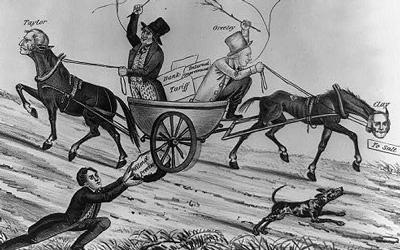
Description
This political cartoon was published in 1848 and showed the deep divisions among the leaders of the Whig Party. Horace Greeley, a prominent newspaper editor and abolitionist, tries to steer the Whigs towards Salt River, or political doom. An Uncle Sam figure tries to steer…
Know-Nothing National Platform, July 13, 1855
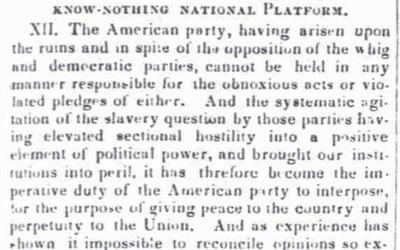
Description
This 1855 article is the national platform of the new Know-Nothing Party, which arose in reaction to the sectional crisis surrounding the issue of slavery. The Know-Nothings were also known as the American Party and surrounded themselves with nativist ideas. They were anti-…
Grand Democratic Free Soil Banner, 1848
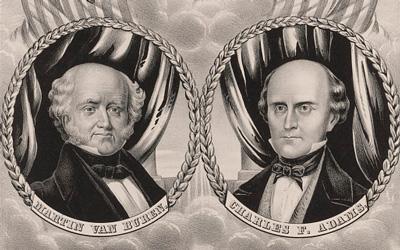
Description
This banner promoted the Free Soil Party and its candidates in the 1848 presidential election. Martin Van Buren (left), who had previously been elected president as a Democrat in 1836, was the candidate for the Free Soil Party. The other man on the banner was Charles F.…
"Marriage of the Free Soil and Liberty Parties," 1848
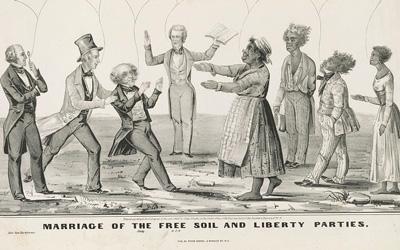
Description
This political cartoon shows the alliance created by the Free Soil and Liberty Parties for the election of 1848. Martin Van Buren, the champion of the Free Soil Party, is shown marrying an African-American woman. The ceremony is presided over by Benjamin Butler, an ally of…
Governor James Grimes' Letter to the Citizens of Iowa, February 12, 1856

Description
Iowa Governor James Grimes wrote this brief letter to the "Citizens of Iowa" anonymously. He wrote to urge people to attend a meeting regarding the founding of the Republican Party in Iowa. At the time he wrote this, Grimes was governor and part of the Whig Party. The Whig…
Grand National Union Banner, 1860

Description
This banner was produced for the Constitutional Union Party to promote their candidates in the presidential election of 1860. The Constitutional Union Party kept the union of the states at the forefront of their party platform to the exclusion of all other issues. The…
Federalist Paper No. 10, November 22, 1787
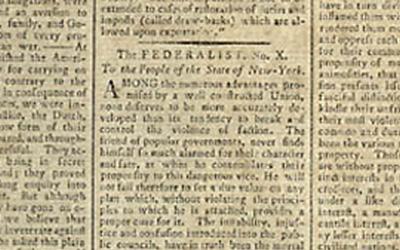
Description
James Madison, along with John Jay and Alexander Hamilton, anonymously wrote a series of essays in New York to convince that state to ratify the federal U.S. Constitution written in Philadelphia in 1787. In Federalist Paper No. 10, Madison writes about how the proposed…
President George Washington's Farewell Address, September 19, 1796
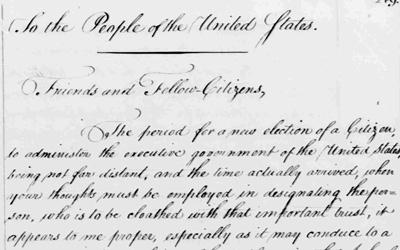
Description
When he decided not to run for a third term as president, George Washington wrote a farewell to the nation. In his "Farewell Address," Washington offered his advice to the citizens of the United States. His key points were to warn Americans against the danger of political…
Letter from Former President Andrew Jackson to Amos Kendall, June 2, 1840

Description
Andrew Jackson wrote this letter to Amos Kendall, journalist, politician and lawyer, during the contentious presidential election year of 1840. From his home in Tennessee, the former president continued to direct the path of the new Democratic party.
"Old Des Moines Awake!" Newspaper Article, July 23, 1840
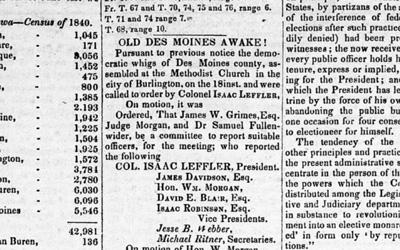
Description
This newspaper article is the written record of a meeting of the Whig Party in Des Moines County in the Iowa Territory in 1840. The minutes of the meeting address the dissatisfaction with the Democratic administration. Iowa was not yet a state. This article gives a glimpse…
"True Republican Ticket" Ballot, 1860
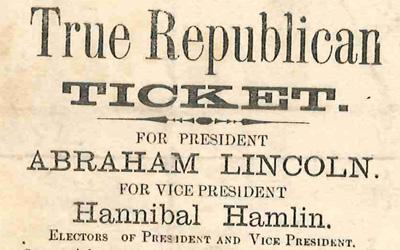
Description
Before the secret ballot was adopted, voting was done publicly. Political parties actually gave ballots like this one to members. When it was time for someone to cast their vote, they took the straight ticket ballot and put it in the voting box.
Additional Resources:
- Founding Brothers: The Revolutionary Generations by Joseph Ellis
This is a Pulitzer Prize-winning book written by Joseph Ellis, a professor of history at Mount Holyoke College, that explores selected interactions among individuals who profoundly influenced the early development of the United States. - "The History and Principles of the Whigs in the Territory of Iowa" from The Iowa Journal of History and Politics
This entry in The Iowa Journal of History and Politics focuses on the origin of the Whig Party in the territory of Iowa. The essay highlights the history of the party and its prominent politicians in the state. - "The Know Nothings in Iowa: Opportunity and Frustration in Antebellum Politics" from The Annals of Iowa
This scholarly essay from The Annals of Iowa looks at the story of the Know-Nothing Party in Iowa, which was an outburst of nativistic sentiment that has - from time to time - punctuated American history.
Iowa Core Social Studies Standards (8th Grade)
Listed below are the Iowa Core Social Studies content anchor standards that are best reflected in this source set. The content standards applied to this set are middle school-age level and encompass the key disciplines that make up social studies for eighth-grade students.
| No. | Standard Description |
| SS.8.13. | Explain the powers and responsibilities of citizens, political parties, and the media in a variety of governmental and nongovernmental contexts. |
| SS.8.14. | Examine and explain the origins, functions and structure of government with reference to the US Constitution and other founding documents, branches of government, bureaucracies, and other systems and its effectiveness on citizens. (21st century skills) |
| SS.8.21. | Analyze connections among early American historical events and developments in broader historical contexts. |
| SS.8.23. | Explain multiple causes and effects of events and developments in early American history. |